Author: Marshall Schott
Taking its name from the city in which it was developed by Anton Dreher in 1841, Vienna Lager pairs the crispness of pale lager with a slightly heftier maltiness more characteristic of English Ale. While the style receives relatively little attention in Europe these days, it’s fairly common to find both craft and corporate versions on tap in North America, which may be related to the fact Swiss expat and brewer, Santiago Graf, popularized the style while living in Mexico.
Vienna Lager traditionally ranges between pale amber and dark copper in color, though Mexican variants tend to be a tad darker due to the use of darker malts, which can lend the beer a touch more roasty character. The BJCP describes Vienna Lager as:
A moderate-strength amber lager with a soft, smooth maltiness and moderate bitterness, yet finishing relatively dry. The malt flavor is clean, bready-rich, and somewhat toasty, with an elegant impression derived from quality base malts and process, not specialty malts and adjuncts.
I became a fan of Vienna Lager before I even knew what Vienna Lager was– a buddy of mine in college had a thing for a certain green bottled amber lager, and I had no interest in letting him drink alone. As my obsession with beer intensified, I found myself regularly going with and generally enjoying whatever amber lager was on tap. Negra Modelo, Boston Lager, Devil’s Backbone Vienna Lager, Yuengling– all tasty examples in my book.
Despite this love, I avoided brewing a Vienna Lager of my own for years because I accepted lager brewing dogma with fervor and was convinced my clumsy ass would surely screw something up. Then I started asking questions that led to xBmts that produced results that ultimately caused me to loosen my grip on convention. I’ve since brewed Vienna Lager many times using various methods, some have even gone on to fare well in competition, but I couldn’t help but wonder what would happen if I cut as many corners in the brewing process as possible.
| BREWING THE BEER |
Over the last few years, I’ve brewed many Vienna Lagers and ultimately settled on a very simple recipe, which I adapted for this Short & Shoddy version.
Short & Shoddy Vienna Lager
Recipe Details
| Batch Size | Boil Time | IBU | SRM | Est. OG | Est. FG | ABV |
|---|---|---|---|---|---|---|
| 5.2 gal | 20 min | 24.0 IBUs | 11.9 SRM | 1.054 | 1.013 | 5.4 % |
| Actuals | 1.054 | 1.013 | 5.4 % | |||
Fermentables
| Name | Amount | % |
|---|---|---|
| Vanora Vienna-style Malt (Mecca Grade) | 12.25 lbs | 98.99 |
| Pale Chocolate Malt | 2 oz | 1.01 |
Hops
| Name | Amount | Time | Use | Form | Alpha % |
|---|---|---|---|---|---|
| Tettnang (2016) | 28 g | 20 min | First Wort | Pellet | 3.5 |
| Magnum | 11 g | 20 min | First Wort | Pellet | 12.9 |
| Tettnang (2016) | 28 g | 10 min | Boil | Pellet | 3.5 |
Yeast
| Name | Lab | Attenuation | Temperature |
|---|---|---|---|
| Harvest (L17) | Imperial Yeast | 72% | 50°F - 60°F |
Notes
| Water Profile: Fresno tap, filtered, with a little dab of gypsum and calcium chloride |
Download
| Download this recipe's BeerXML file |
At 11:05 AM one cool December morning, I began filtering the water for this BIAB batch, dosing it with a little gypsum and calcium chloride.
With the full volume of water collected, my assistant hit the switch to start heating it up.
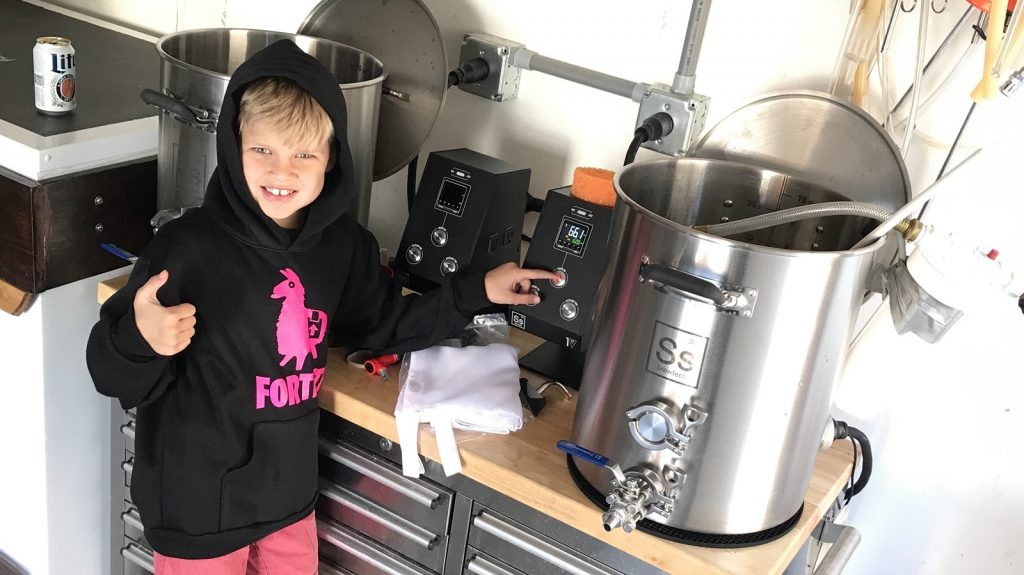
As the water was heating, I weighed out and milled the grains directly into my BIAB fabric filter.
Next, I prepared the relatively small amount of kettle hops.
Once the water was at strike temperature, I adjusted the controller to mash mode before dropping the grains in, giving a quick stir to break up any dough balls.
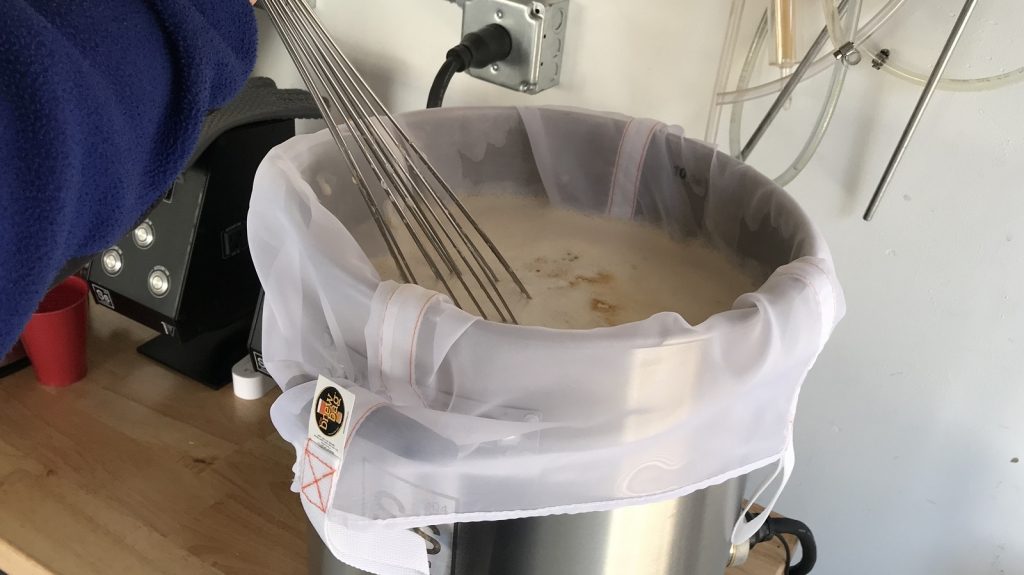
I then verified my target mash temperature was reached.
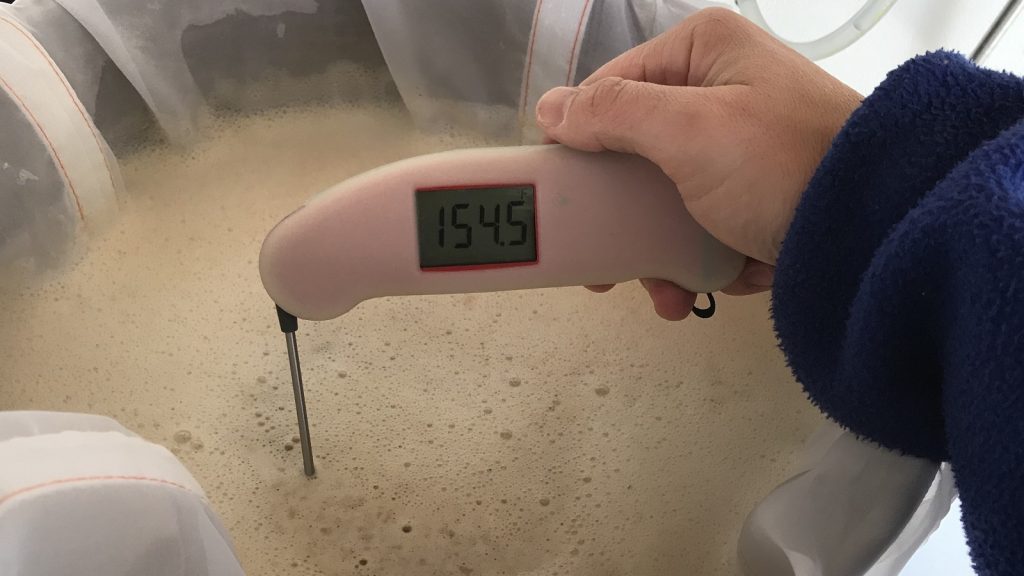
After a brief 25 minute mash rest, I removed the grain bag, tossed in the first wort hop addition, then cranked the power back up.
The wort was boiled for just 20 minutes with hops added as stated in the recipe.
At the end of the short boil, I quickly chilled the wort with my immersion chiller.
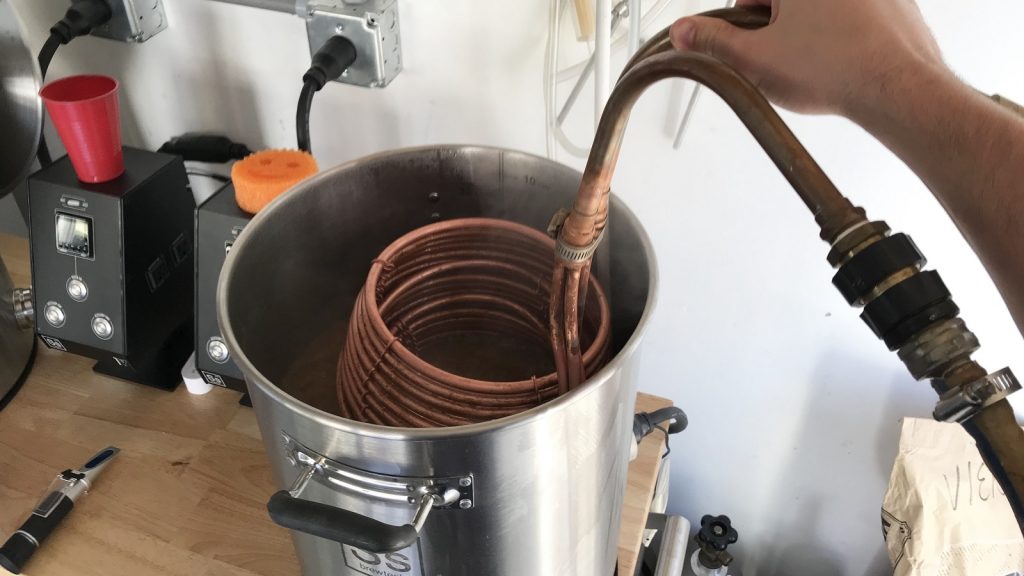
A refractometer reading suggested my brewhouse efficiency was slightly better than I planned– 63% rather than the 58% I was getting prior to switching to electric.
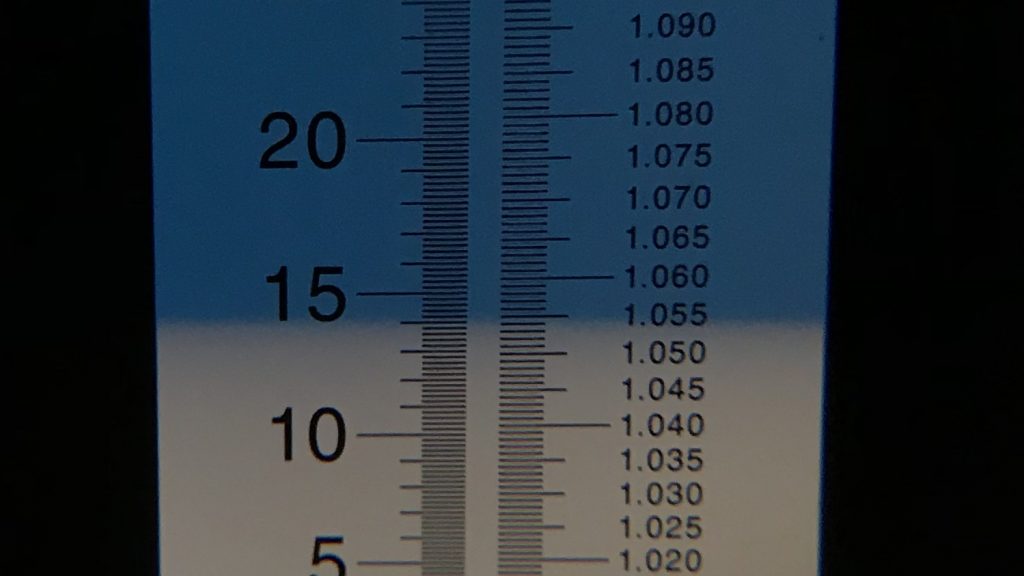
The wort was immediately racked to a sanitized Brew Bucket.
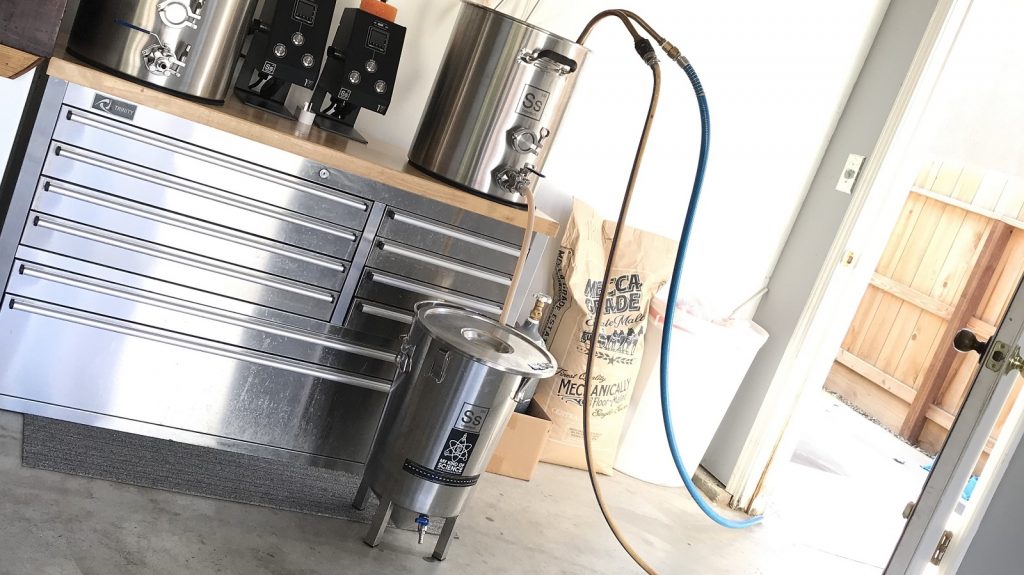
My chamber was occupied at the time, so I placed the filled fermentor on a cart then proceeded to pitch a single pouch of Imperial Yeast L17 Harvest directly into the 66°F/19°C wort. The time was 1:02 PM, less than 2 hours after starting this brew day.
The beer was left on a cart in my garage, which ranged in temperature from 62°F/17°C to 68°F/20°C. Bubbling in the airlock was observed just a few hours after pitching the yeast and fermentation occurred without issue. With signs of activity absent after 8 days, I took a hydrometer measurement that indicated the beer was sitting at the 1.013 target. The beer was transferred to a sanitized keg that got placed in my cool keezer where it sat for 18 hours before I returned to add gelatin fining. The beer was burst carbonated overnight, after which I reduced to the gas to serving pressure and let it cold condition for 3 more days before serving it to participants.
| RESULTS |
A total of 18 people of various levels of experience participated in this Short & Shoddy evaluation. Participants were first asked to identify the style they believed the beer to be based on their perception.
Tasters were then instructed to rate how hoppy, malty, and dry they perceived the beer to be on a 0-5 scale where a rating of 0 indicated “not at all” and 5 indicated “extremely;” these ratings were then averaged.
Tasters were provided a list of common hop, malt, and yeast characteristics then instructed to select from each the one they perceived as being strongest in the beer.
Hop Characteristics
Malt Characteristics
Yeast Characteristics
Next, participants were asked to indicate whether or not they detected any off-flavors in the beer; those who did were provided a list of common off-flavors and instructed to select the one they perceived as being strongest. A total of 3 out of the 18 tasters reported perceiving various off-flavors in this beer with one each noting diacetyl, acetaldehyde, and phenols.
Tasters were then asked to rate how much they enjoyed the beer on a 0-5 scale where 0 indicated they hated it and 5 indicated they loved it.
Finally, the beer style was revealed to participants and they were asked to rate how representative it was on a 0-5 scale where 0 meant “not at all” and 5 meant “exactly.”
My Impressions: I’ve brewed this recipe multiple times now using various methods, but this was my first time using a full-on Short & Shoddy approach, and to me, it didn’t seem to have any detrimental impact. The only thing different about this beer compared to past batches was a distinct sweet, almost vanilla-like richness, something I’ve come to expect from Mecca Grade Estate Malts. I loved it!
| CONCLUSION |
Like all beers fermented with saccharomyces pastorianus, Vienna Lager is believed by many to require various methodological considerations in order to produce a good example. Despite it’s darker color, Vienna Lager is similar to its paler cousins in that there really isn’t much to hide behind, putting any potential flaws on display.
Typical methods for brewing Vienna Lager involve 60 to 90 mash rests to encourage full conversion and attenuation, 90 minute boils to drive off DMS, high yeast pitch rates, and of course fermentation around 50°F/10°C to suppress ester development. Interestingly, tasters who were unaware of the Short & Shoddy nature of this Vienna Lager seemed to notice nothing particularly off about it, in fact only 3 of 18 noted off-flavors, and they all perceived something different. Moreover, participants had rather positive opinions of the beer, averaging a preference rating of 3.7 out of 5.
Given the difficulty people have with blind style identification, it’s not terribly surprising only 1 person accurately identified it as a Vienna Lager, though a broader perspective reveals 1/3 felt it was an amber lager of some sort. Perhaps more telling is the data regarding tasters’ thoughts on how closely the beer represented a Vienna Lager once the style was revealed– 78% rated it as being a 3 out of 5 with one person thinking it was an exact match.
Toasty malt flavor and subtle noble hop character with all of the clean crispness of a lager. This is why I love Vienna Lager! Having brewed numerous Short & Shoddy versions of other styles, my expectations have admittedly shifted to the extent I wasn’t really anxious how this batch would turn out. Imperial Yeast L17 Harvest remains one of my favorite yeasts of all time, producing a very “beery” flavor that I absolutely adore, even when fermented blasphemously warm. There’s no doubt I’ll be brewing up this Short & Shoddy Vienna Lager recipe again in the future!
If you have thoughts about this Short & Shoddy brew, please feel free to share in the comments section below!
Support Brülosophy In Style!
All designs are available in various colors and sizes on Amazon!
Follow Brülosophy on:
FACEBOOK | TWITTER | INSTAGRAM
If you enjoy this stuff and feel compelled to support Brulosophy.com, please check out the Support page for details on how you can very easily do so. Thanks!


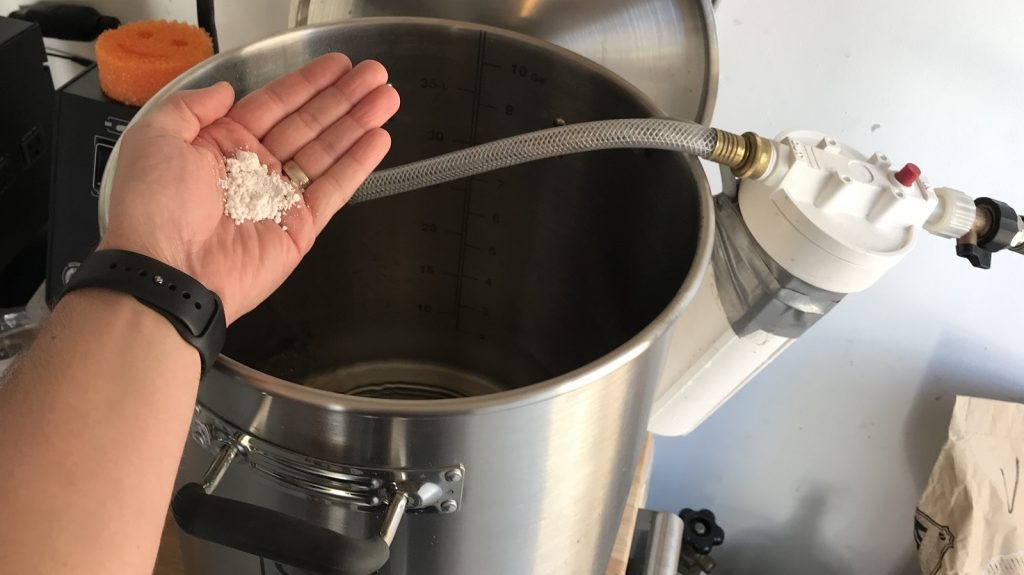
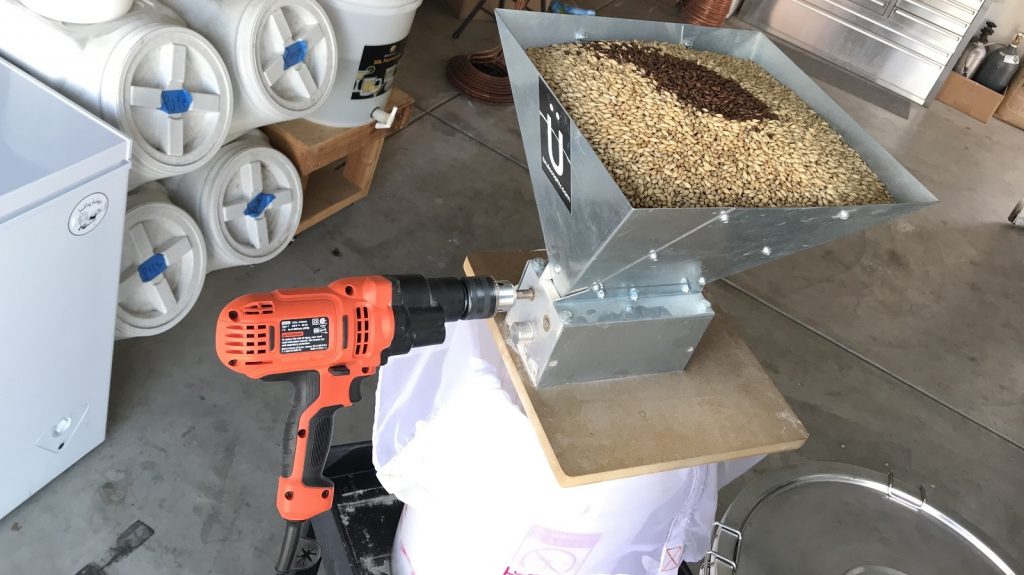
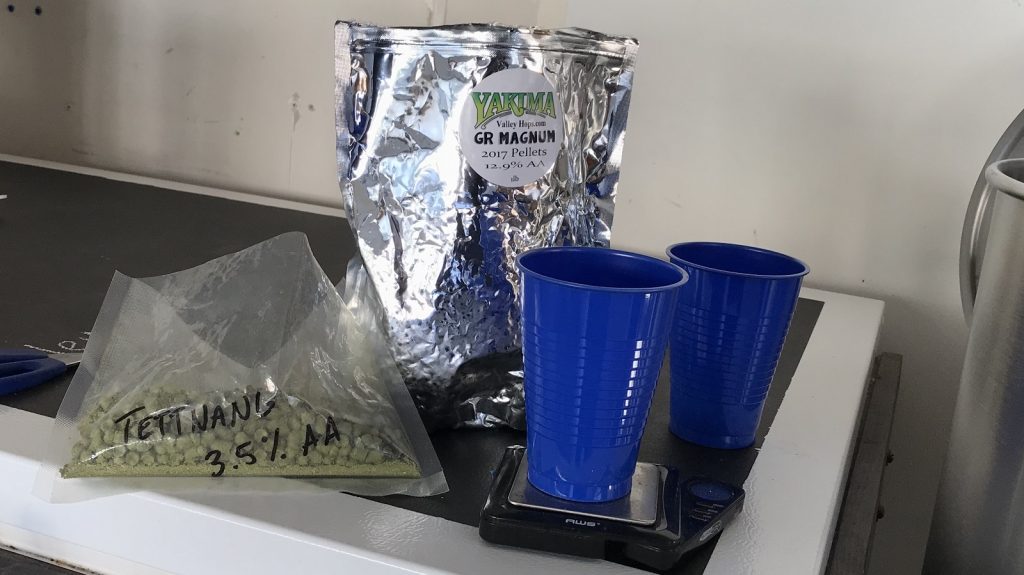
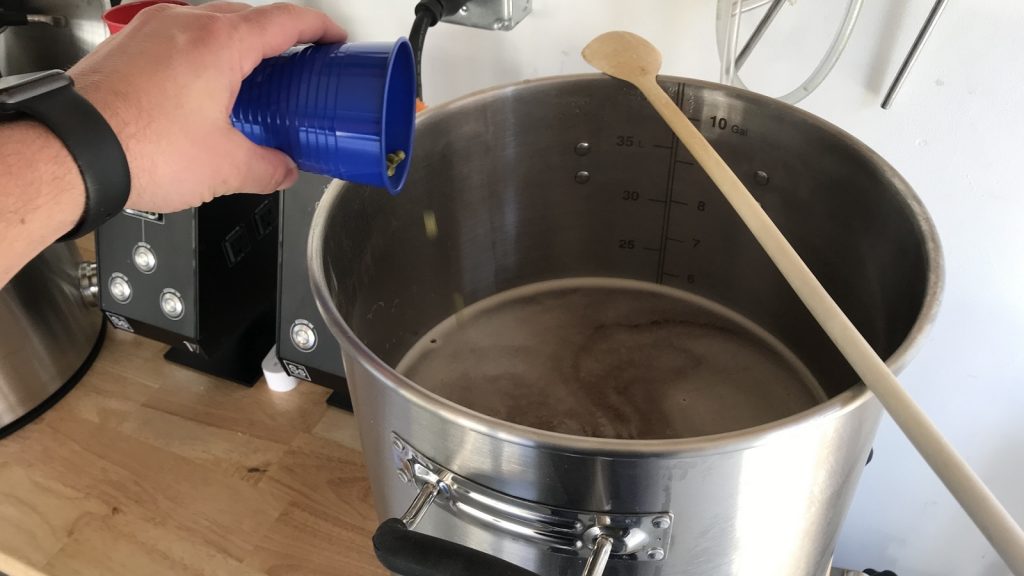
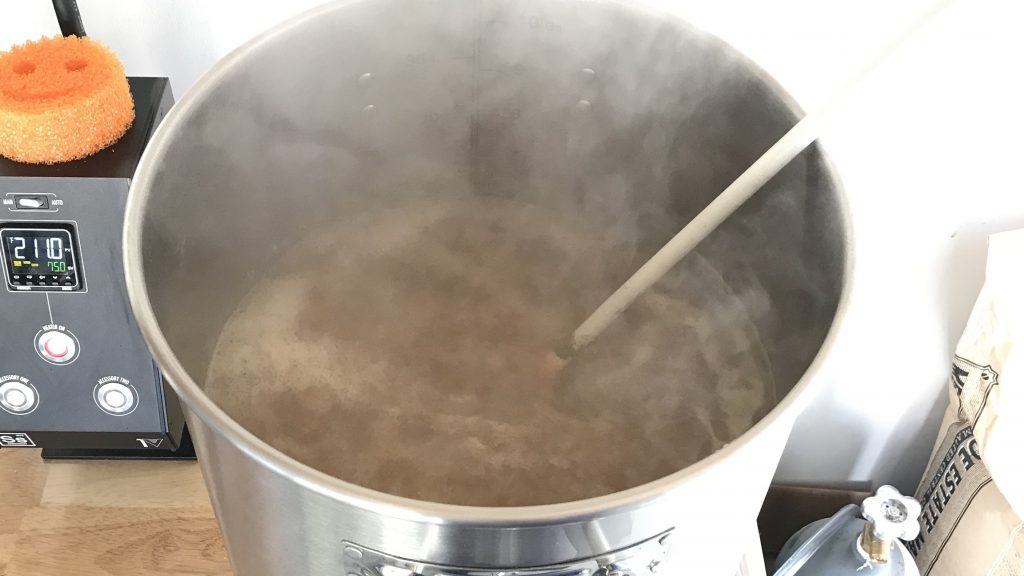
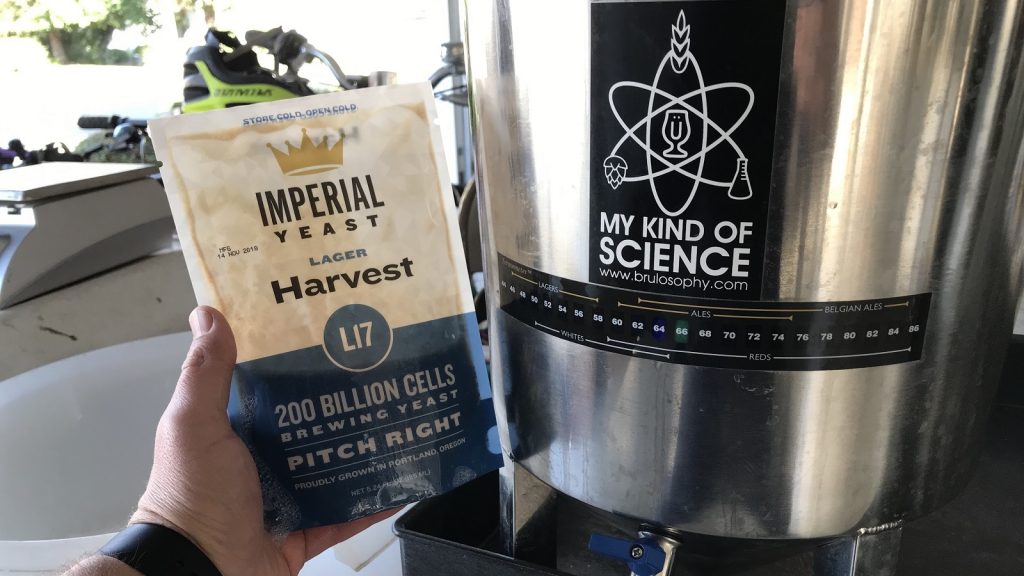
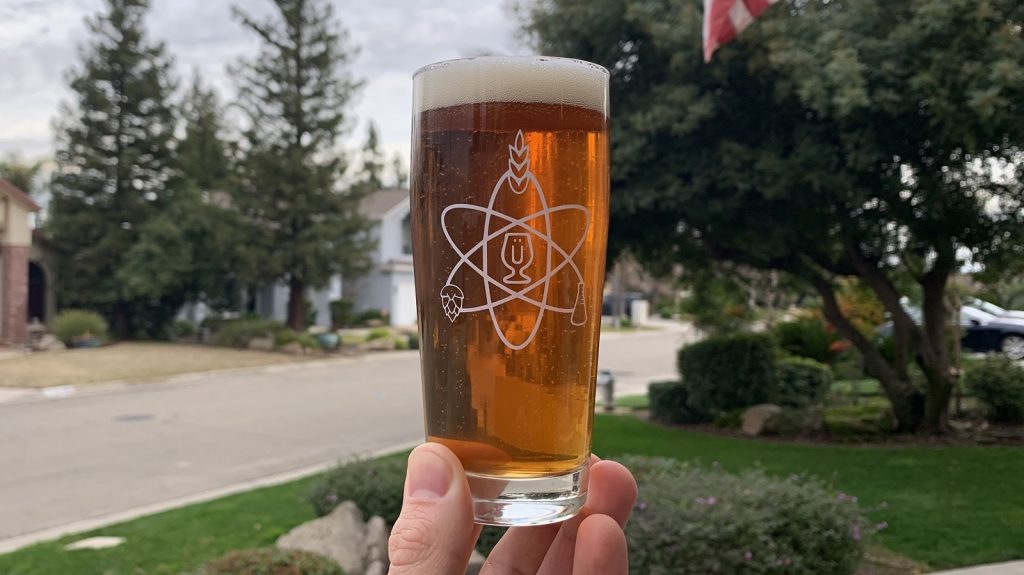
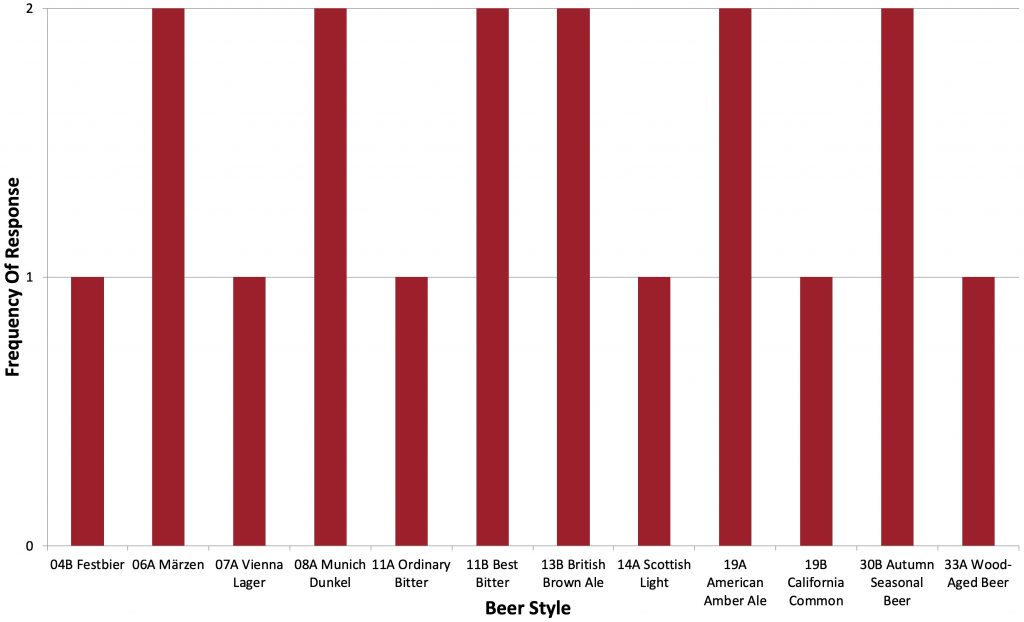
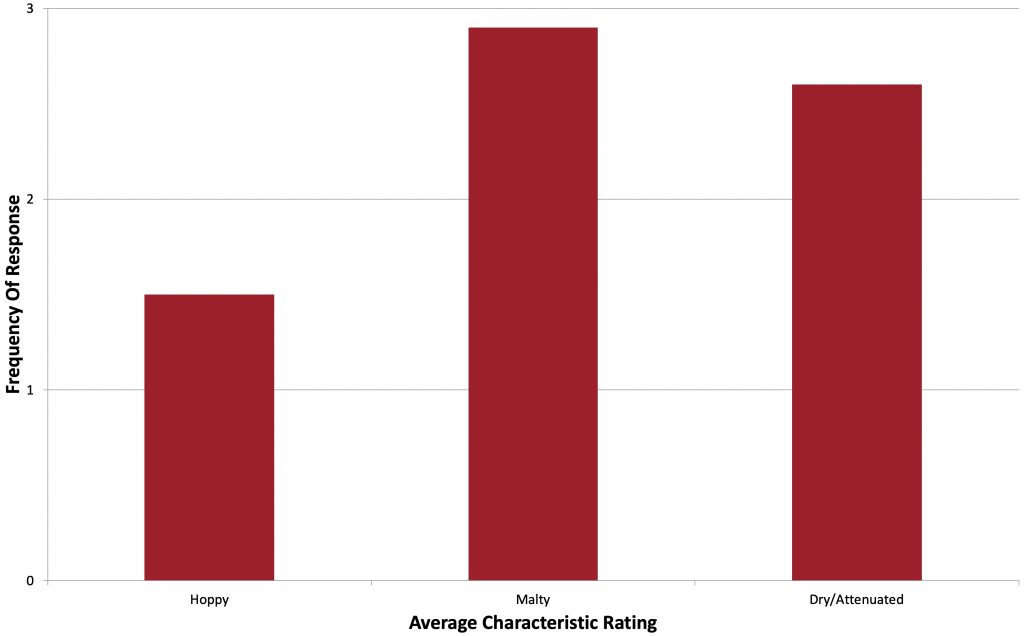

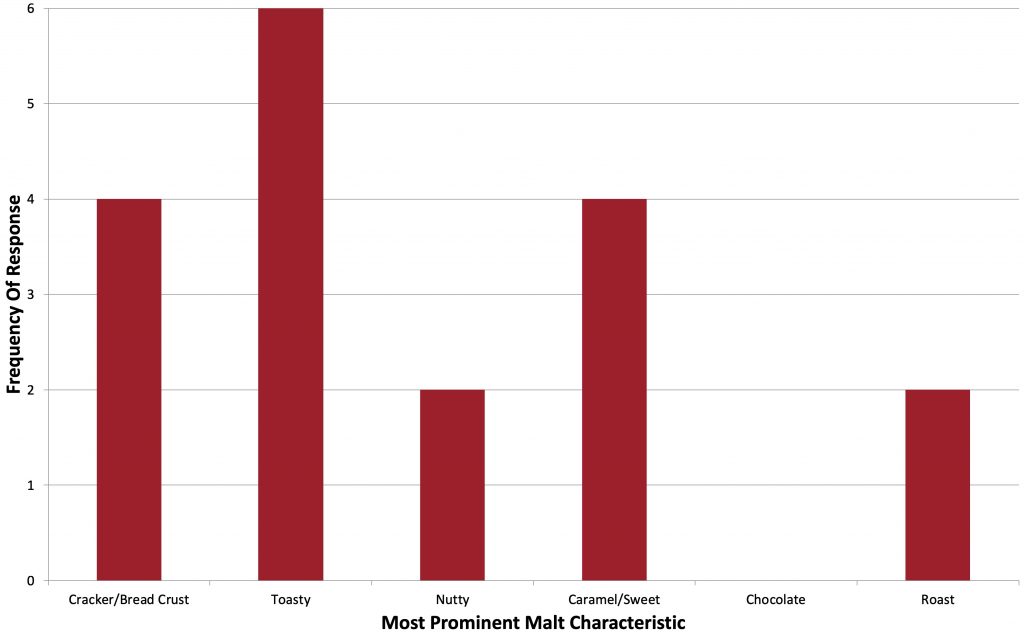













23 thoughts on “Short & Shoddy | Vienna Lager”
A style I love to drink!I haven’t nailed my own recipe yet, though. Maybe I just need to go a bit simpler, like what you’ve got here. My eyeballs tell me it tastes great..
Most come down to 2 malts. Vienna and Pale Choc. Some like a hint of Munich and some like tiny bit of Melanoiden. I personally like 95% Vienna, 2.5% Choc and 2.5% melanoiden.
Magnum / Saaz combo are good too.
Outside of terrible sanitization practices and bad recipes, what does it take to make truly awful beer at this point? I’m interested in seeing A REALLY shoddy brew (bad yeast practices, untreated tap water without adjustments, no temperature control) vs this type of shoddy (where you abbreviate variables but still hit the high points of water chemistry, pitch temp, etc.) vs a very technically strict brew (RO water with adjustments, yeast starter, long boil, carefully controlled pitching and fermenting temps, etc.) using something like a pilsner or Helles so any defects really show up.
Sounds like a great beer and fun to make.
I’m confused about Negra Modelo. Their website claims it’s a Munich Lager, not a Vienna. I’ve heard for years that it’s a Vienna style from other sources as well. Why do people believe this.
I think because NM is at least somewhat based off of Graf’s interpretation of Vienna Lager.
Curious your thoughts on substituting/adding a small % of brown malt to a Vienna lager? Do you think it would bring too much coffee flavor to the party? Or just accentuate the toast of the Vienna malt and the chocolate flavor of the pale chocolate malt?
I’ve used Brown Malt precisely once and it seemed to impart a nice nutty character that would probably go well in a Vienna. I might use it in the same 1-3% range.
I find myself repeating, “blasphemy!” every time I read one of these damn S&S xbmts.
You suggested, but did not make it clear, that you fermented this at 66f the whole time? Or was this also typical “fast ferment” lager method?
It is blasphemy, that’s what makes it fun!
I left the beer in my garage that stayed around 62-68F the whole time. I don’t do the quick lager method anymore, just ferment with yeasts I know work well at ale temps.
I love that you chose Miller Lite for hydration through the brew process lol
A fine Pilsner, indeed.
Your refractometer shows 1.054 OG, but if you look at the Brix number it’s 14 Brix. But if you look at the conversion here: https://www.winning-homebrew.com/specific-gravity-to-brix.html 1.054 is 13.32 brix.
If you look at this page – https://brulosophy.com/2014/09/08/refractometers-are-they-really-worth-it/ you could see in the picture that the brix scale there is different
Meh. Prior to fermentation, simply multiplying the brix by 4 is always within a point or what a hydro would show in a normal sub-1.060-ish beer. The picture shows about 14 brix, times 4 is 56, or 1.056.
1.054 vs 1.056 is virtually within the margin of error even though the pic looks closer to 1.055 to me ;).
I understand that they are close, but is it an oversight or there are different methods to measure? I would think the device to measure gravity should be marked correctly, but it looks like there are two different scales used on those devices.
That caught my eye too. The scales are misaligned by 2-3 gravity points in the business zone, assuming the left scale is Brix. This is only a problem if you don’t know about it. But, if you’re buying a refractometer from anyone other than a lab supplier with a decent industry reputation, then you should expect this (and worse).
It’s simple enough to calibrate, at least in terms of making yourself an equivalence look-up table.
YES!! Thank you for this, was thinking the other day that I should make Vienna lager and now I have even more motivation to do do.
Imperial harvest is the best. I know Marshall is vocal about his love for the strain, but believe the hype. I became a believer after a couple batches of cold and warm fermented lagers. It’s now my go to lager strain because of its versatility and flavor profile.
What does the pale chocolate malt add as far as flavor?
Pale chocolate is very unique in that it adds a noticeable roasted nuttiness to beer, particularly when used in small amounts. For Vienna Lager, I find it really adds a character that rounds out the beer. Absolutely fantastic stuff.
Great write up, Marshall. Love all the S&S trials so far. You mentioned you’ve put this recipe into competition in the past. A S&S write up I’d love to see is all of the above PLUS the evaluation notes from 1 or 2 competitions it’s entered into!
Hi, how do you calculate the bitterness when using FWH for a 20 min boil? Do you calculate as if the hops are boiled for 20 min, or do you add an additional 10 min in the calculations to account for the time is takes to heat the water to boiling temperature?
web.Brewfather.app takes care of that for me